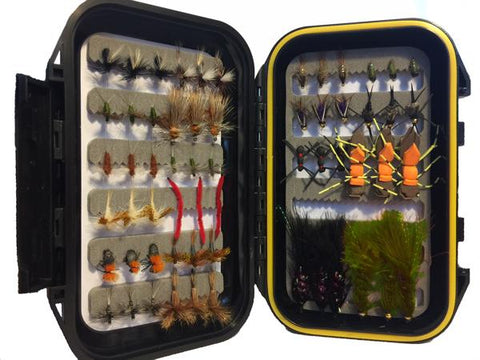When it comes to choosing fly fishing gear, the amount of choices are overwhelming. Many people want to give fly fishing a try, but don’t know where to start. When you’re looking to purchase gear, the first and most important thing you should do is determine what type of fly fishing you will be doing.
Each area of the world has unique fish and water. Be sure to fully understand the water you will be fishing before you make any gear decisions.
Fly Fishing Gear Selection Chart with links to Product Recommendations:
| Fish | Water Type | Kit Recommendation | Click Links Below to See Listings |
| Small trout and panfish less than 2 pounds | small stream, lots of trees |
5'6", 3wt 7', 3/4 wt |
|
| Small trout and panfish less than 2 pounds | med to large stream or pond, lake | 9', 5/6 weight | |
| Largemouth Bass, Smallmouth Bass, Pike, Large Trout, carp | open water | 7 or 8 weight | |
| Stripers, bonefish, bluefish, false albacore, redfish | open water, bays, marshes, flats |
7 or 8 weight 9 or 10 weight |
|
| Salmon, big pike | big rivers, open water | 9 or 10 weight | 9/10 weight Freshwater Kits |
| Big saltwater, musky | open water | 12 weight | 12 weight Kits |
A note about selecting a rod for kids learning to fly fish:
If you are shopping for a kid, Thanks! Taking a kid fishing is great for a child's development! Many people think a small person needs a small rod but our advice is to get the longer, perhaps even heavier, rod. Why? Well, there are two reasons. First, kids usually have no problem handling the longer rod. The rods are light and easy to handle. Second, it will help them have a better experience. They are less likely to break a 9' rod than the lighter 7' or 5'6" rods. They can also reach out longer distances with their rod. Being young, they already don't have the reach of an adult or the experience at casting a fly rod. The longer rod helps with that. If you are still skeptical remember, THEY GROW UP FAST! If it is too long for them now, it will only be a short time until they fit into it. The important thing is to take them fishing early and make memories.
What rod do I need?
Two things matter here: how big is the water and how big are the fish
If you fish open water or big rivers a longer rod is helpful. If you fish small streams use a shorter rod.
Fly fishing rods range from 00 to 14 weights. A 00-weight is the lightest rod you can purchase and 14-weights are often the heaviest rod you can find. Wild Water offers 3-12 weight rods.
If you purchase a 3-weight rod, you’re likely targeting small panfish or trout. It is light and is very sensitive. A 9, 10 or 12-weight is going to handle larger salt or freshwater fish. 7 and 8-weights are good for big trout, pike and bass. They also do great in saltwater.
If you want a rod weight that is versatile, a 9 foot, 5 or 6-weight rod is going to be the perfect choice. These weights of rods will work in small streams, wide rivers and lakes. They can handle sizable trout, bass and even some pike (if you are careful). You can also target smaller saltwater fish like Speckled Sea Trout or Redfish with a 5 or 6-weight. These rods are not too heavy and learning how to cast with a 5 or 6-weight is by far the most common way to go.

Most Popular KIT - Deluxe 9 Foot 5/6-Weight
For beginners, it’s never a bad idea to purchase a full, packaged setup. You’ll receive everything you need (rod, reel, line, etc.) without having to worry about matching the weights. As you gain experience, you can mix and match with whatever style of gear you like.
Browse All Fly Fishing Starter Packages
What reel do I need?
You need your reel to match your rod. A common mistake anglers make is choosing a reel that is too light or too heavy for their rod. Reels are weighted exactly like rods. The only difference is that many reels allow you to attach to two or more different line weights. For example, a reel may be rated as a 5/6. This means you can put 5 or 6-weight line on the reel and use it with a 5 or 6 weight rod. If you attach a reel that doesn’t fit the rod, you’ll ruin the balance of your setup. If your reel is too light, you’re not only in danger of losing a larger fish due to less power, but the casting distance is also lessened. If your reel is too heavy, you’ll lose your ability to make technical casts. A bottom-heavy rod makes it difficult to properly place your casts.
What fly line do I need?
Fly line is another tricky aspect of fly fishing. Depending on what type of fishing you’re doing, you’ll need a different line.
FLOATING FLY LINE - If you’re using flies that float, you’ll want a floating line. The floating line will keep your fly on the surface and keep it closer to the surface as the fly absorbs water. These are usually brightly colored fly lines.
SINKING FLY LINE - If you are fishing with streamers and other bottom searching flies, sinking line is a great option. This line is a bit heavier and will quickly get you to the necessary depths. Be careful with this line, because you can get snagged on underwater obstacles. Sinking lines come in different sink rates. Sink rates are given in inches per minute. These lines are usually dark in color.
SINKING TIP FLY LINES - Sinking tip lines are a good hybrid when you want to be below the water but want to see your line and avoid snags. The sinking portion is about 15 feet. The sinking and floating sections are different colors with the tip being dark and the floating portion being a brighter color for visibility.
FLY LINE TAPERS - A weight forward taper is the most popular design today. It is easiest to cast. Double tapers are not as good for casting but offer the benefit of twice the life by using both ends. Level lines are super affordable because they have no taper and are easy to manufacture. They offer the lowest distance and casting accuracy of all the fly line designs.
Browse All Fly Lines
BACKING: What is backing? Why do I need it? What kind do I need?
Backing is what you put on before you attach your fly line to your reel. It provides extra insurance if a big fish runs and takes all the fly line. It fills the reel to make retrieve faster. It isn't needed but it does solve a few important fly fishing problems and makes the experience easier.
Backing is often 20 or 30 pound braided Dacron that is in place in case a large fish takes all of your fly line. Wild Water has bright orange braided Dacron backing and bright yellow Gel-spun backing. Gel-spun backing is great because you can put much more on your reel due to its' smaller diameter. Be sure to attach backing to the fly reel using the arbor knot and then tie the fly line to the backing with a Albright knot.
Tippet/Leader
Leader and tippet choices all depend on the type of fishing you’re doing. Size is shown as 0X, 1X, 2X, 3X, 4X, etc. The higher the number, the smaller the diameter of the tippet. If you’re targeting trout and other small to medium sized fish, you’ll only need a 5X leader. This is thick enough to withstand any headshakes or runs that fish this size might give you. The leader is what you attach directly to your fly line using a nail knot.
For tippet, smaller diameter is better for fooling fish because it is harder for them to see. The smaller diameter is not as strong so you have to balance strength and stealth. Tippet should be the same size or a size smaller size than your leader. For example, if you have 5x leader, use 5x or 6x tippet . 5X leader and tippet is light enough that the spooky trout won’t see it and strong enough that you’ll be able to handle some larger fish. You’ll attach the tippet to the leader with a double surgeon’s knot.
Flies
For flies, you’ll need to choose the ones that match what the fish in your area are eating. Typically, that means bait fish, insects, fish eggs or crustaceans. Looking at local hatch charts can help you decide which insect imitating patterns to try out. Try to find out what the fish are eating before you go out. If you don't know ahead of time, getting some standard fly patterns will usually work. Some great versatile flies are Wooly Buggers, Elk Hair Caddis , Adams, Black Ant and Gold Ribbed Hares Ear Nymphs.









